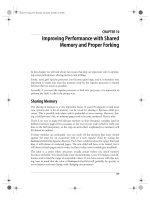Organizational behavior 5e by kinichi Chap008KF improving performance with feedback, rewards, and positive reinforcement
Bạn đang xem bản rút gọn của tài liệu. Xem và tải ngay bản đầy đủ của tài liệu tại đây (904.53 KB, 40 trang )
Improving
Performance
with
Feedback,
Rewards, and
Positive
Reinforcement
Chapter Eight
McGraw-Hill/Irwin
© 2012 The McGraw-Hill Companies, Inc. All rights reserved.
Copyright © 2012 by The McGraw-Hill Companies, Inc. All rights reserved.
After reading the material in this chapter,
you should be able to:
LO8.1 Specify the two basic functions of
feedback and three sources of feedback.
LO8.2 Define upward feedback and 360degree feedback, and summarize the
general tips for giving good feedback.
LO8.3 Distinguish between extrinsic and
intrinsic rewards, and give a job-related
example of each
8-2
After reading the material in this chapter,
you should be able to:
LO8.4 Summarize the research lessons about pay
for performance, and explain why rewards
often fail to motivate employees.
LO8.5 State Thorndike’s “law of effect” and explain
Skinner’s distinction between respondent and
operant behavior.
LO8.6 Demonstrate your knowledge of positive
reinforcement, negative reinforcement,
punishment, and extinction and explain
behavior
shaping
8-3
Improving Individual Job
Performance
8-4
Providing Effective Feedback
Feedback
information about
individual or
collective
performance shared
with those in a
position to improve
the situation
8-5
Two Functions of Feedback
Instructional
clarifies roles or teaches new behaviors
Motivational
serves as a reward or promise of a reward
Feedback enhances the effect of specific, difficult
goals
8-6
Question?
Grant is responsible for training new employees.
He wants to make sure everyone knows their role
in making the firm successful. This is __________
feedback.
A.Persistent
B.Motivational
C.Tutorial
D.Instructional
8-7
Sources of Feedback
Others
peers, supervisors, lower-level employees, and
outsiders
Task
Oneself
Self-serving bias and other perceptual
problems can contaminate this source
8-8
Behavioral Outcomes of Feedback
8-9
Popularity of Nontraditional
Feedback
1. Traditional performance appraisal systems have
created widespread dissatisfaction.
2. Team-based organization structures are replacing
traditional hierarchies.
3. Multiple-rater systems are said to make feedback
more valid than single-source feedback.
8-10
Popularity of Nontraditional
Feedback
4. Advanced computer network technology greatly
facilitates multiple-rater systems.
5. Bottom-up feedback meshes nicely with the trend
toward participative management and employee
empowerment.
6. Co-workers and lower-level employees are said
to know more about a manager’s strengths and
limitations.
8-11
Nontraditional Feedback
Upward feedback
lower-level employees provide feedback on a
manager’s style and performance
360-Degree feedback
Letting individuals compare their own perceived
performance with behaviorally specific (and
usually anonymous) performance information
from their manager, subordinates, and peers
8-12
Question?
When Janine evaluates her supervisor, she is
providing __________ feedback.
A.Upward
B.Downward
C.Horizontal
D.Diagonal
8-13
Upward Feedback
Managers resist upward feedbacks programs
because they believe it erodes their authority
Anonymous upward feedback can become little
more than a personality contest
8-14
Feedback Do’s and Don’ts
Do not:
1. Use feedback is used to punish, embarrass, or put
down employees.
2. Provide feedback that is irrelevant to the person’s
work.
3. Provide feedback that is too late to do any good.
8-15
Feedback Do’s and Don’ts
4. Provide feedback about something that is
beyond the individual’s control.
5. Provide feedback that is overly complex or
difficult to understand.
8-16
Feedback Do’s and Don’ts
Do:
1. Keep feedback relevant by relating it to existing
goals.
2. Deliver feedback as soon as possible to the time
the behavior was displayed.
3. Provide specific and descriptive feedback.
8-17
Feedback Do’s and Don’ts
4. Focus the feedback on things employees can
control.
5. Be honest, developmental, and constructive.
6. Facilitate two-way communication—give the
other person the opportunity to clarify and
respond
8-18
Key Factors in Organizational
Reward Systems
8-19
Types of Rewards
Extrinsic rewards
financial, material, or social rewards from the
environment
Intrinsic rewards
self-granted, psychic rewards
8-20
Question?
Angelo derives pleasure from the task of book writing
itself. He can be described as __________ motivated.
A.Extrinsically
B.Financially
C.Materially
D.Intrinsically
8-21
Distribution Criteria
Performance: results
tangible outcomes
Performance: actions and behaviors
teamwork, cooperation, risk-taking
Non-performance considerations
contractual
8-22
Pay for Performance
Pay for
performance
monetary incentives
linking at least some
portion of the
paycheck directly to
results or
accomplishments
8-23
Why Rewards Fail to Motivate
1.
2.
3.
4.
5.
Too much emphasis on monetary rewards
Rewards lack an “appreciation effect”
Extensive benefits become entitlements
Counterproductive behavior is rewarded
Too long a delay between performance and
rewards
8-24
Why Rewards Fail to Motivate
6. Too many one-size-fits-all rewards
7. Use of one-shot rewards with a short-lived
motivational impact
8. Continued use of demotivating practices such as
layoffs, across-the-board raises and cuts, and
excessive executive compensation
8-25









